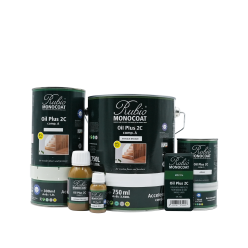
How to remove paint from wood?
In recent years, there’s been a growing trend towards using natural and eco-friendly products. This is also true for wood care products, with many people moving away from harsh chemicals and opting for more natural alternatives. This is where wood oil comes in.


How to Remove Paint from Wood
Removing paint from wood is a common challenge faced in many refurbishing projects, whether it's for renewing vintage furniture, reviving old wooden floors, or preparing a surface for a fresh coat of paint. The process is not just about stripping paint - it's about doing so in a way that maintains the wood's structural and aesthetic integrity. So in this article, we’ll learn how to remove paint from wood efficiently and easily by using the right tools and techniques.
Safety Precautions
Safety should always be your first consideration when deciding how to strip paint from wood. Protective gear is essential for this task, as you’ll be dealing with some possible dangers. This includes gloves to protect your hands from harsh chemicals, goggles to shield your eyes from splinters and chemical splashes, and a mask to prevent inhalation of potentially toxic fumes. Working in a well-ventilated area is also really important, especially when using chemical-based paint removers. Opt for eco-friendly, non-toxic paint removers when available. These are safer for both personal health and the environment.
Tools and Materials
Stripping paint off wood requires insight into the right set of tools and materials to do the job right. Prepare yourself with the following equipment before working on the wood:
- Scrapers: Try to gather a variety of sizes, as this helps in removing loose paint from different areas.
- Sandpaper: Have a range of grits available, from coarse for initial removal to fine for finishing touches.
- Paint Stripper: Eco-friendly options are preferable as they are safer for yourself and the environment.
- Protective Coverings: Drop cloths or plastic sheets will protect the surrounding area from paint and chemicals.




Assessing the Paint and Wood
The type of paint and the condition of the wood are key factors in determining the best removal approach. Learning how to remove gloss paint from wood differs from emulsion. Learning how to remove old paint from wood means testing for lead. Lead-based paints, commonly used before the 1970s, require specific safety measures and disposal methods due to their toxicity. The condition of the wood also dictates the gentleness or aggressiveness of the removal method needed.
Methods for Paint Removal
There are a few different methods that you can try out when it comes to paint removal. Your best bet is to give yourself as much variety as possible here to tackle some of the potential challenges you’ll come across. Some of the best methods include:
- Scraping
- Sanding
- Chemical Paint Strippers
- Heat Guns
Scraping
Scraping is often the first step in paint removal. It's a manual process that involves using a scraper to gently lift and peel away loose and flaking paint. This method is less aggressive than others and can help preserve the underlying wood. It's important to use a steady hand and work carefully to avoid damaging the wood surface.
Sanding
Sanding is effective in removing the more stubborn paint layers. Starting with a coarser grit sandpaper to remove the bulk of the paint, you can gradually move to finer grits to achieve a smooth, clean surface. Sanding should always be done in the direction of the wood grain to prevent unnecessary scratches or damage.
Chemical Paint Strippers
For more challenging paint removal tasks, chemical paint strippers can be a powerful solution. These products work by breaking down the paint, making it easier to scrape or wipe away. It's important to follow the manufacturer's instructions for safe and effective use, including any specific application techniques and necessary wait times. After removing the paint, the wood often requires neutralisation to remove any chemical residue.
Heat Guns
Heat guns offer another method for softening and lifting paint. When using a heat gun, it's essential to keep the tool moving to avoid burning the wood. The softened paint can then be scraped off. This method requires careful attention to avoid overheating the wood or causing burns.




Step-by-Step Paint Removal Process
So, now that you know what it takes to remove paint from wood, let’s go over the process with a step-by-step guide for paint removal:
- Area Preparation:
Begin by laying protective coverings around your work area to catch falling paint and debris.
- Application of Paint Stripper:If using a chemical stripper, apply it evenly across the surface and allow it to sit as directed.
- Scraping Paint: Once the paint is loosened, use scrapers to remove it from the wood gently.
- Sanding the Surface:After scraping, sand the surface starting with a coarse grit and moving to finer grits for a smooth finish.
- Cleaning: Thoroughly clean the wood to remove all paint and chemical residues.
- Detail Work:For intricate areas or detailed woodwork, use smaller tools and repeat the scraping and sanding process as needed.
Safety and Environmental Considerations
Disposing of paint chips and chemicals requires careful consideration. Never dispose of these materials in household rubbish or down drains. Your best bet is to bag it up and take it to your local household waste and recycling centre, as they will be able to dispose of it safely.
Finishing Your Wooden Surface
After the paint is removed, finishing the wood is the final step. Oil Plus 2C is the recommended product. It not only enhances the wood's natural beauty but also provides a durable, protective finish. Oil Plus 2C is particularly useful because it only requires a single coat to work, is eco-friendly, and is available in a range of colours - suitable for all wood types!





